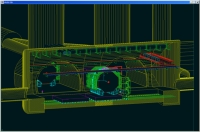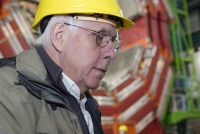 |
 |
|||||||||||||
|
|||||||||||||
|
|||||||||||||
|
Alain Hervé already has the experience of building two enormous detectors under his belt, and it looks like he is going to help in a third one. Technical coordinator at CERN of both L3 at LEP and CMS at the LHC, the Breton has now been called as an expert to help in the interaction region design, cavern and detector assembly planning for the ILC and its detectors. He is taking part in preparatory phone conferences for the IRENG workshop and co-convenes Work Group A that looks at how to design, install and open experiments.
In 1991 the CMS collaboration accepted a plan proposed by Hervé and decided that their experiment would be built on the surface. The two main reasons for this decision were easier access to the detector parts in the surface hall, and best use of time: the assembly could already start while civil engineering work in the underground cavern was still going on. This new concept also posed new challenges though: the assembled detector has to be lowered 100 metres underground in 15 different slices weighing between 350 and 2000 tons - no bumping against shaft walls allowed! Three quarters of the massive CMS detector, including the 2000-ton main slice, have already been lowered underground without any problem. “The ILC will face similar problems,” says Hervé. How and when can you start the assembly? When are the civil engineering works and commissioning finished? What is the minimum size of the cavern? He received the first phone calls from the ILC community at the end of last year after the machine-detector interface group visited CERN and the idea of the push-pull concept first came up. Instead of two detectors sitting at two interaction points at the same time, the decision was taken to let the two detectors share one interaction point: while one is pushed onto the interaction region, the other one is pulled out. This configuration can be changed up to once a month. What started out with “very specific questions” on cavern size and design led to his new role as co-convener of Work Group A for the IRENG workshop, together with Tom Markiewicz, Tomoyuki Sanuki and Yasuhiro Sugimoto. “This afternoon we have a videoconference about shafts. Shafts are expensive, but if you don't have enough you could jeopardise the physics results,” he says. CMS shaft planning was easier because it only needed one big shaft to lower the slices; with push-pull, either you need two large shafts or one shaft is likely to be closer to one of the two experiments, making it more difficult to access the other one. On the upside, the ILC detectors are also likely to be shorter, so that fewer parts have to be lowered underground. Once underground, the ILC detectors will benefit from the CMS experience as well. Cable chains in complicated loops, leads, tunnels fill the CMS cavern. They make it possible to open each slice of the detector without having to recable the millions of outputs and plugs - “a novelty,” says the technical coordinator. Even more of a challenge: water, gas and cooling leads, which are not as easy to move around, are also integrated in the cable chains. At CMS, all these cables and pipes lead into the neighbouring service cavern through diagonal holes in the wall which stop stray radiation. For a change, this will be simpler for the ILC experiments because the radiation level is lower and the number of cables and services will be reduced due to the smaller collision rate. Another lesson to learn from CMS might be fire protection in the cavern. The entire (enormous) underground space can be filled with foam within 15 minutes to quench the fire. Lifts, staircases and escape tunnels are pressurised so that people can always escape protected from smoke. “The ILC community has to take a careful look at fire risks,” Hervé says. Many of these caveats and tips will come in handy when the interaction region community meets at SLAC this month. NewsLine will cover the meeting in a future issue. -- Barbara Warmbein |
|||||||||||||
| © International Linear Collider |

